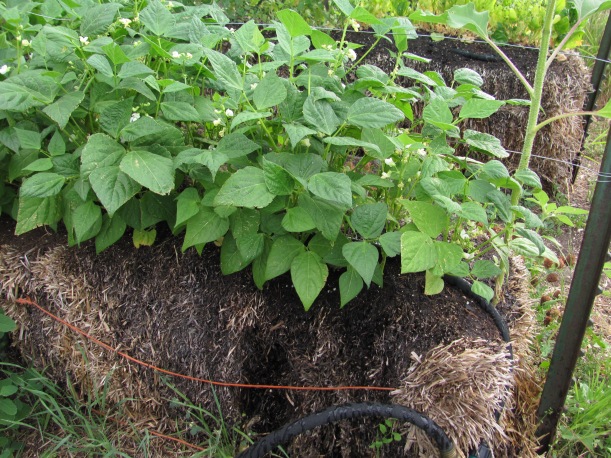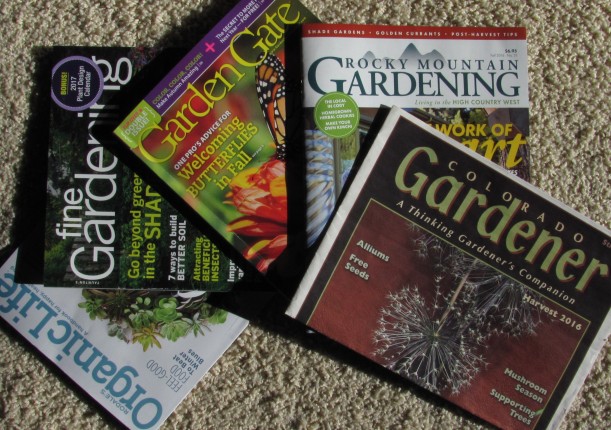 Published Dec. 4, 2016, in the Wyoming Tribune Eagle, “Holiday gifts for the gardener on your list.”
Published Dec. 4, 2016, in the Wyoming Tribune Eagle, “Holiday gifts for the gardener on your list.”
By Barb Gorges
I asked members of the Laramie County Master Gardeners for their top picks for gardening magazines and books to give you ideas for gifts for the gardeners you know.
Gardening conditions in Cheyenne are somewhat unique so advice from these publications must be taken with a bit of local knowledge:
1) We have alkaline soils so ignore advice to add lime and wood ash;
2) We are officially in USDA plant hardiness zone 5 but microclimates can be harsher or milder;
3) Our average annual precipitation is 15 inches. Even if you run your well dry, you can’t reproduce a wetter, more humid location, which some plants require, like somewhere else in Zone 5—say southern Iowa.
MAGAZINES
Most of the magazines recommended are available at local bookstores. Discounted multi-year subscriptions and back issues are available online.
We are lucky that Colorado’s gardening climate is close to Cheyenne’s, making our local choice The Colorado Gardener (www.ColoradoGardener.com, free at outlets, including the Cheyenne Botanic Gardens, and online, or $18/5 issues/year delivered). It is a full-color, tabloid-style, 16-page newsmagazine. In addition to articles and a calendar of Front Range garden-related events, even the advertising is informative.
Another option is Rocky Mountain Gardening (www.RockyMountainGardening.com, $24/4 issues/year). Previously known as “Zone 4,” it covers Idaho, Montana, Wyoming, Colorado and Utah. It was recommended by Catherine Wissner, horticulturist at the Laramie County Cooperative Extension office, and several other respondents. Topics in a recent issue included hellstrip gardening (the hot, dry strip along the curb) and frost blankets (written by a Smoot, Wyoming, gardener). Wyoming is well-represented in the news section.
Judy Kowrach was one of two people who endorsed Garden Gate (www.GardenGateMagazine.com, $20/6 issues/year). With no ads, it is full of tips, plant profiles and design ideas. Despite its Iowa origins, much of the information is applicable to Cheyenne. Even without a subscription, you can sign up online for its free eNotes.
Kim Parker and several others listed Fine Gardening (www.FineGardening.com, $29.95/6 issues/year). It does a splendid job of inciting people to commit acts of gardening. I like their warnings on which featured plants are officially classified as invasive in which state and their scientific plant name pronunciation guide. And their deep website full of free garden and plant information.
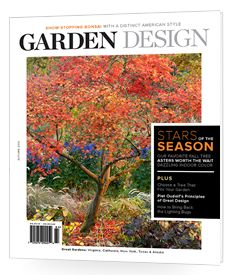 I couldn’t come up with an issue of Garden Design (www.GardenDesign.com, $45/4 issues/year), but looking at a preview copy online, it also is sumptuously photographed. Its price reflects the 148 ad-free pages per issue. And its website is also full of free information, even for non-subscribers.
I couldn’t come up with an issue of Garden Design (www.GardenDesign.com, $45/4 issues/year), but looking at a preview copy online, it also is sumptuously photographed. Its price reflects the 148 ad-free pages per issue. And its website is also full of free information, even for non-subscribers.
Finally, Rodale’s Organic Life (www.RodalesOrganicLife.com, $15/6 issues/year) is the latest incarnation of Rodale’s Organic Gardening and Farming. In 1978, that publication printed my interview of a man who built a better bluebird house. These days, think of it as the organic version of Better Homes and Gardens—mostly lifestyle, little gardening.
BOOKS
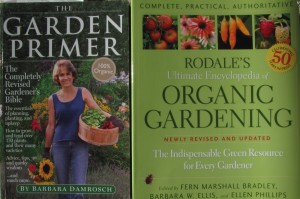 My primary garden book, recommended to me several years ago by Shane Smith, director of the Cheyenne Botanic Gardens, is The Garden Primer by Barbara Damrosch (2008, Workman Publishing, 820 pages). Written by a gardener from the cold climate of Maine, it covers every aspect of organic home gardening in well-organized chapters, but with an index for quick consultation.
My primary garden book, recommended to me several years ago by Shane Smith, director of the Cheyenne Botanic Gardens, is The Garden Primer by Barbara Damrosch (2008, Workman Publishing, 820 pages). Written by a gardener from the cold climate of Maine, it covers every aspect of organic home gardening in well-organized chapters, but with an index for quick consultation.
Another option is Rodale’s Ultimate Encyclopedia of Organic Gardening (2009, www.rodaleinc.com, 720 pages). Earlier editions have been on my shelf for years. It’s a tad more technical, but both this and The Garden Primer are good how-to guides and problem solvers.
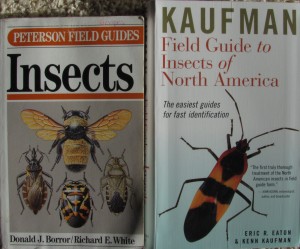 Tava Collins recommended National Audubon Society Field Guide to Insects and Spiders (1980, Alfred A. Knopf, $20) for help identifying garden friends and foes. Similar guides are available in the Kaufman and Peterson field guide series.
Tava Collins recommended National Audubon Society Field Guide to Insects and Spiders (1980, Alfred A. Knopf, $20) for help identifying garden friends and foes. Similar guides are available in the Kaufman and Peterson field guide series.
Collins also recommended three books written by Colorado gardeners: Rocky Mountain Gardener’s Handbook, John Cretti (2012, Cool Springs Press); Rocky Mountain Getting Started Garden Guide, John Cretti (2015, Cool Springs Press); and Cutting Edge Gardening in the Intermountain West, Marcia Tatroe (2007, Big Earth Publishing).
For special gardening techniques that will work in our area, these next two were recommended.
Marie Madison cited The Bountiful Container: Create Container Gardens of Vegetables, Herbs, Fruits and Edible Flowers by Maggie Stuckey and Rose Marie Nicholas McGee (2002, Workman Publishing).
Susan Carlson, who I interviewed a few months ago about straw bale gardening, apprised me of a new edition of her favorite book: Straw Bale Gardens Complete: All-New Information on Urban & Small Spaces, Organics, Saving Water – Make Your Own Bales With or Without Straw by Joel Karsten (2015, Cool Springs Press, $24.99).
If your giftee’s interest is in growing native plants that attract pollinators or in identifying plants on the prairie, try these. Keep in mind the definition of “weeds” depends on the situation.
 Carlson listed Rangeland Plants: Wyoming Tough by Smith et. al. (2015, publication B-1265) It is a free download at www.wyoextension.org/publications or $8 at the Laramie County Extension office, 307-633-4383.
Carlson listed Rangeland Plants: Wyoming Tough by Smith et. al. (2015, publication B-1265) It is a free download at www.wyoextension.org/publications or $8 at the Laramie County Extension office, 307-633-4383.
Richard Steele found Weeds of the West (Western Society of Weed Science, 2012, $34 at www.wsweedscience.org) to be particularly useful while manning the “Ask a Master Gardener” table at the farmers market this fall.
Collins mentioned the classic Meet the Natives: A Field Guide to Rocky Mountain Wildflowers, Trees and Shrubs: Bridging the Gap between Trail and Garden by M. Walter Pesman. It was revised by Denver Botanic Gardens staff in 2012 and republished by Big Earth Publishing.
 The author of one of my favorites, The Undaunted Garden: Planting for Weather-Resilient Beauty (2010, Fulcrum Publishing), Lauren Springer Ogden, is a firm believer in “the right plant in the right place” and is the originator of “hellstrip” gardening. Her photography is inspiring. She speaks often at garden events on the Front Range.
The author of one of my favorites, The Undaunted Garden: Planting for Weather-Resilient Beauty (2010, Fulcrum Publishing), Lauren Springer Ogden, is a firm believer in “the right plant in the right place” and is the originator of “hellstrip” gardening. Her photography is inspiring. She speaks often at garden events on the Front Range.
Her book would be a good accompaniment to the next two books, helping you to pick appropriate local plants to interpret their lessons. These books are about planet-friendly landscape gardening.
Planting in a Post-Wild World: Designing Plant Communities for Resilient Landscapes by Thomas Rainer and Claudia West (2015, Timber Press). This may be intended to introduce landscape designers to more natural, sustainable plantings. But you can apply the advice to your own yard, such as using groundcover plants instead of shredded bark mulch everywhere.
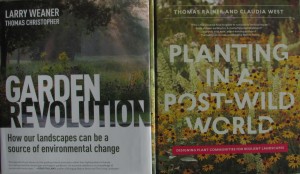 The other is Garden Revolution: How Our Landscapes Can Be a Source of Environmental Change by Larry Weaner and Thomas Christopher (2016, Timber Press). Proponents of the “right plant in the right place” too, the authors have designed this book to help you understand their premise: that with knowledge of your eco region and local habitat, you can plant a garden that will evolve over time with a minimal amount of assistance, i.e. chemicals and labor.
The other is Garden Revolution: How Our Landscapes Can Be a Source of Environmental Change by Larry Weaner and Thomas Christopher (2016, Timber Press). Proponents of the “right plant in the right place” too, the authors have designed this book to help you understand their premise: that with knowledge of your eco region and local habitat, you can plant a garden that will evolve over time with a minimal amount of assistance, i.e. chemicals and labor.
LECTURES AND CLASSES
One option: Give your favorite gardener tuition for the 10-week Master Gardener class beginning in January. For more information, call 307-633-4383.
Or give them tickets to the spring gardening lecture series Laramie County Master Gardeners is offering in conjunction with the Cheyenne Botanic Gardens. Call 307-637-6458.





